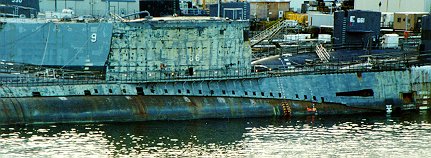In October of 1998, I was sent an email describing some of the
problems with Triton (including a flooded engine room) while she was in storage at
Norfolk. The author has asked to be not identified.
Thank you anyway, it is a great story..
The problem we had was not during defueling. The Triton was defueled at Newport News Shipyard Vs Norfolk Navy Yard. It had been defueled and out of commission for several years. We didn't know at first why the No. 1 engine room flooded. Divers went down and didn't find anything. It took on water through an open flange where a pump had been removed without shutting off the sea connection valve or bolting a blank over the open flange. I went down with the fire dept. and walked on the bilge board in water up to my belt line. I found the open flange where water was gushing in and a thin inspection aluminum cover in the near vicinity of it. I took bolts out of a ladder and a shop person stood on top and we put the inspection cover over the opening so the fire dept. could get some of the water pumped out. After getting the water down, we found the hull valve (which had the handwheel laying in the bilge) and shut if off. The next day the Engineer in charge of the inactive storage was transferred to Non-Nuc service and I took it over for about a year or two.
When we docked it, we found a hole about as big as your thumb in the No. 9 ballast tank (which had been there long enough for barnacles to grow inside the tank). The Pipe from that pump flange where water came in ran from the pump to the sea , through the ballast tank. This pipe developed a hole and it took on water via the ballast tank. That boat had so many ballast tanks it didn't noticeably change the draft. The flood alarm system was a local system and when it took on water the float rose high enough to break the wires and the alarm only was active from the time the flooding started until it broke the wires.
At that time there was no requirement for inactive ships to have two valve shutoff to the sea. Also only a quarter inch plate was welded over the sea opening. Chapter 50 got changed partially at my insistence to require two valve sea shutoff and two plates welded over all sea openings. Also the alarm system was connected to the shipyards alarms where it would be monitored for 24 hours a day. To make a long story --longer-- It was quite an experience for a country boy. That boat has two plants which is like a commercial plant on the East coast North of Virginia. They were always using parts from it and I overheard an NRRO officer say it probably will not be scrapped as long as the commercial plant was active.
The layout from Forward to stern (in a line): No. 1 RC, No. 2 RC (back to back -Mirror image) then : No. 1 Engine Rm, the No. 2 Engine Rm. It had very little activity because it had half lifed away. There was some monitored piping and vent system to the diesel engine exhaust where they vented the RC through the diesel's exhaust system. This was among the first one to go inactive and when the took it out of commission a lot of her "collectibles" (such as caps, insignia, silverware, etc. was stored in a locked quarters). Probably a lot of that stuff just disappeared when they were putting the tow package and towing bridle on her. It fell my lot to trim her for dry-docking to repair the damaged ballast tank, paint it, etc. While looking for tanks to put water in for trimming purposes I found a 20 pound bag of navy beans that had been stashed behind a seat in one of the messing areas. They had been there so long that when I dumped them overboard the beans floated around the ship for several days before sinking. (I couldn't use the peak tank for it had a hole in it just below the water line and it wouldn't fill). One more nickels worth: The ballast tanks on that boat were on the outside like saddle tanks similar to the old WWII subs. (She was over 500 feet long).
Sorry, if I got too long winded.. It just brought back many memories for me.
Again, Thanks you putting the info on the net.
Anonymously submitted, October 1998 ...
